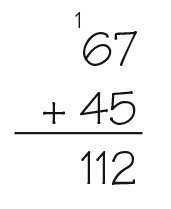Students practice a variety of mental math and paper-and-pencil addition methods with two-digit and three-digit numbers. They estimate and check for reasonableness, and explore the efficiency and usefulness of the strategies in various situations.
Content in this Lesson
- Using and applying place value concepts to make connections among representations of numbers [E1].
-
Solving two-digit and three-digit addition problems using mental math
strategies [E3]. - Solving two-digit and three-digit addition problems using paper-and-pencil methods [E4].
- Estimating sums using mental math strategies [E6].
- Choosing good tools and efficient strategies for solving problems [MPE2].
- Determining the reasonableness of a solution to an addition problem [MPE3].
- Checking calculations [MPE4].
- Communicating solution strategies and reasoning [MPE5].
Assessment in this Lesson
| ASSESSMENT | EXPECTATION ASSESSED | MATH PRACTICES EXPECTATION ASSESSED |
|---|---|---|
|
Addition Strategies Workshop Menu Self-Check Student Activity Book Page 357 |
|
|
|
Addition Strategies Quiz With Feedback Box Student Activity Book Pages 369–371 |
|
|


















